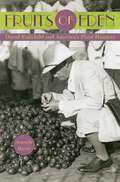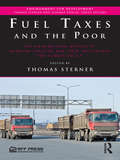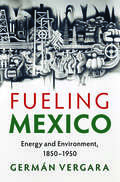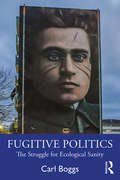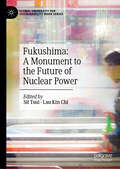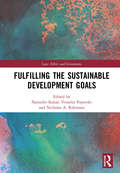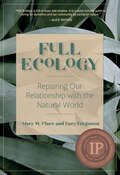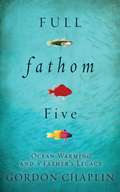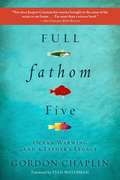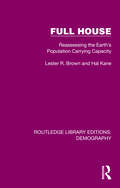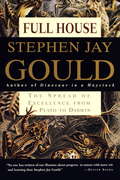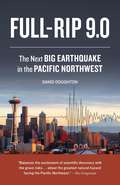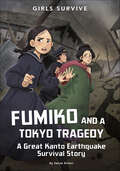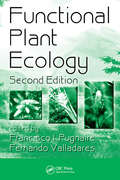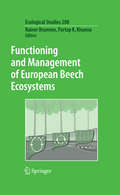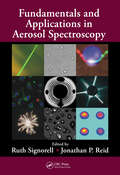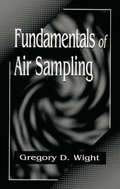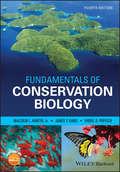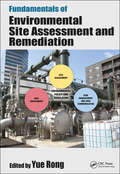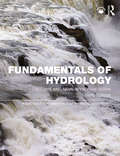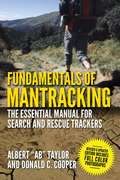- Table View
- List View
Fruits of Eden: David Fairchild and America's Plant Hunters
by Amanda HarrisAt the turn of the nineteenth century—when most food in America was bland and brown and few people appreciated the economic potential of then-exotic foods—David Fairchild convinced the U.S. Department of Agriculture to finance overseas explorations to find and bring back foreign cultivars. Fairchild traveled to remote corners of the globe, searching for fruits, vegetables, and grains that could find a new home in American fields and in the American diet.In Fruits of Eden, Amanda Harris vividly recounts the exploits of Fairchild and his small band of adventurers and botanists as they traversed distant lands—Algeria, Baghdad, Cape Town, Hong Kong, Java, and Zanzibar—to return with new and exciting flavors. Their expeditions led to a renaissance not only at the dinner table but also in horticulture, providing diversity of crops for farmers across the country.Not everyone was supportive, however. The scientific community was concerned with invasive species, and World War I fanned the flames of xenophobia in Washington. Adversaries who believed Fairchild’s discoveries would contaminate the purity of native crops eventually shut down his program, but his legacy lives on in today’s modern kitchen, where navel oranges, Meyer lemons, honeydew melons, soybeans, and durum wheat are now standard.
Fuel Taxes and the Poor: The Distributional Effects of Gasoline Taxation and Their Implications for Climate Policy (Environment For Development Ser.)
by Thomas SternerFuel Taxes and the Poor challenges the conventional wisdom that gasoline taxation, an important and much-debated instrument of climate policy, has a disproportionately detrimental effect on poor people. Increased fuel taxes carry the potential to mitigate carbon emissions, reduce congestion, and improve local urban environment. As such, higher gasoline taxes could prove to be a fundamental part of any climate action plan. However, they have been resisted by powerful lobbies that have persuaded people that increased fuel taxation would be regressive. Reporting on examples of over two dozen countries, this book sets out to empirically investigate this claim. The authors conclude that while there may be some slight regressivity in some high-income countries, as a general rule, fuel taxation is a progressive policy particularly in low income countries. Rich countries can correct for regressivity by cutting back on other taxes that adversely affect poor people, or by spending more money on services for the poor. Meanwhile, in low-income countries, poor people spend a very small share of their money on fuel for transport. Some costs from fuel taxes may be passed on to poor people through more expensive public transportation and food transport. Nevertheless, in general the authors find that gasoline taxes become more progressive as the income of the country in question decreases. This book provides strong arguments for the proponents of environmental taxation. It has immediate policy implications at the intersection of multiple subject areas, including transportation, environmental regulation, development studies, and climate change. Published with Environment for Development initiative.
Fueling Mexico: Energy and Environment, 1850–1950 (Studies in Environment and History)
by Germán VergaraAround the 1830s, parts of Mexico began industrializing using water and wood. By the 1880s, this model faced a growing energy and ecological bottleneck. By the 1950s, fossil fuels powered most of Mexico's economy and society. Looking to the north and across the Atlantic, late nineteenth-century officials and elites concluded that fossil fuels would solve Mexico's energy problem and Mexican industry began introducing coal. But limited domestic deposits and high costs meant that coal never became king in Mexico. Oil instead became the favored fuel for manufacture, transport, and electricity generation. This shift, however, created a paradox of perennial scarcity amidst energy abundance: every new influx of fossil energy led to increased demand. Germán Vergara shows how the decision to power the country's economy with fossil fuels locked Mexico in a cycle of endless, fossil-fueled growth - with serious environmental and social consequences.
Fugitive Politics: The Struggle for Ecological Sanity
by Carl BoggsFugitive Politics explores the intersection between politics and ecology, between the requirements for radical change and the unprecedented challenges posed by the global crisis, a dialectic has rarely been addressed in academia. Across eight chapters, Carl Boggs explores how systemic change may be achieved within the current system, while detailing attempts at achieving change within nation-states. Boggs states that any notion of revolution seems fanciful in the current climate, contending that controlling elites have concentrated their hold on corporate power along three self-serving fronts: technology (Big Tech) and the surveillance order, militarism and the warfare state, and intensification of globalized power. Combined with this Boggs cites the fundamental absence of revolutionary counter-forces, arguing that after decades of subservice relevant, allied to the rise of identity politics and social movements, the Marxist theoretical legacy is now exhausted and will not provide an exit from the crisis. Boggs concludes that the only possibility for fundamental change will come from an open style of politics, in the Jacobin tradition, operating within the overall structures of the current democratic state. Written for both an academic and a general readership, in the U.S. and beyond, Fugitive Politics will be of vital importance to those studying political theory, political philosophy, political history, Marxism and Marxist theory, authoritarian politics, ecology, environmental politics, and climate politics.
Fukushima: A Monument to the Future of Nuclear Power (Global University for Sustainability Book Series)
by Kin Chi Lau Tsui SitThe book is a collection of essays written by scholars/activists who are continuously concerned about the Fukushima catastrophe. The authors engagingly address the devastating environmental, economic, and social consequences of nuclear disasters, as well as recognize resistance of local communities through searching for alternative life and thought. The book offers a critique of nuclear energy and calls for collective action for social justice and ecological justice.
Fulfilling the Sustainable Development Goals: On a Quest for a Sustainable World (Law, Ethics and Governance)
by Narinder Kakar, Vesselin Popovski and Nicolas A. RobinsonThis book contains assessment of the progress, or the lack of it, in implementing the UN Sustainable Development Goals (SDGs). Through review of the assessments and of case studies, readers can draw lessons from the actions that could work to positively address the goals. The 2030 Agenda for Sustainable Development is designed to catalyze action in critical areas of importance to humanity and the planet. The effort to implement the SDGs, however, demands a sense of urgency in the face of environmental degradation, climate change, emerging conflicts, and growing inequality, among a number of other socio-economic problems. Five years after the launch of the 2030 Agenda, this book takes stock of how far the world has come and how we can position ourselves to achieve the global targets. The book is one of the first to assess how the implementation is impeded by the onset of COVID-19. It contains a special chapter on COVID-19 and the SDGs, while many thematic chapters on different SDGs also assess how COVID-19 adversely affects implementation, and what measures could be taken to minimize the adverse effects. This publication thus provides a fresh look at implementation of the SDGs highlighting impactful and creative actions that go beyond the business-as-usual development efforts. The volume reinforces this analysis with expert recommendations on how to support implementation efforts and achieve the SDGs through international and national strategies and the involvement of both the public and private sectors. The result is an indispensable textual tool for policy makers, academia, intergovernmental organizations (IGOs) and non-governmental organizations (NGOs), as well as the public, as we march toward the 2030 deadline.
Full Ecology: Repairing Our Relationship with the Natural World
by Gary Ferguson Mary M. ClareHow to confront the climate crisis without losing heart It’s easy to feel overwhelmed in the face of global climate breakdown. So how might we develop the inner resolve to confront it? Full Ecology, a collaboration between social-cultural psychologist Mary M. Clare and longtime science writer Gary Ferguson, suggests a path forward. Breaking the modern impulse to see humans as separate from nature, Clare and Ferguson encourage us to learn from the &“supremely methodical and highly improvisational&” natural systems that touch our lives. True change, they argue, begins with us stopping and questioning assumptions about our place in the world. From this process of reflection, they offer us an alternative blueprint for acting in ecologically healthy ways, and for inspiring others to do the same. Rather than proposing a ten-step plan to save the earth, this book encourages a more elemental rethinking of our connections to nature, and of how such connections might be strengthened for the common good. Practical and poetic, scientific and spiritual, Full Ecology presents a strong, nourishing foundation for climate action.
Full Fathom Five
by Gordon ChaplinGordon Chaplin's father was a seemingly happy-go-lucky, charismatic adventurer who married a wealthy heiress and somehow transformed himself into the author of a landmark scientific study, Fishes of the Bahamas, published by the Academy of Natural Sciences of Philadelphia. As a young boy, the author took part in collecting specimens for his father. Fifty years later, he was asked to join a team from the same institution studying the state of sea life in the Bahamian waters where he grew up, as measured against his father's benchmark. The first of the sea changes presented in this eloquent book stems from climate change and is the drastic transformation of ocean life due to global warming. The second is his father's miraculous transformation from presumed playboy into scientist. And the third involves the author's own complicated relationship with his parents and in particular his father, as he grew older and assumed the part of the prodigal son. Fifty years later, returning to his childhood home, he delves into the mysteries of his father's life and the impossibility of ever truly recovering the past, or ever returning home.Illustrated with gorgeous color plates from the original Fishes of the Bahamas and featuring descriptions of exquisite undersea beauty and heartrending devastation, this is a status report on climate change unlike any other, both a report from the field and an intensely personal reckoning.
Full Fathom Five: Ocean Warming and a Father's Legacy
by Gordon Chaplin Stan Waterman"Not since Jacques Cousteau has anyone brought us the sense of the ocean as our home . . . Far more than a science book.” -San Francisco Book ReviewGordon Chaplin’s father was a seemingly happy-go-lucky, charismatic adventurer who married a wealthy heiress and transformed himself into the author of a landmark scientific study, Fishes of the Bahamas. The book was published by the Academy of Natural Sciences of Philadelphia, one of America's most esteemed scientific institutions. As a young boy, the author took part in collecting specimens for his father. Fifty years later, he was asked to join a team studying the state of sea life in the Bahamian waters where he grew up, as measured against his father’s benchmark.The first of the sea changes presented in this eloquent book stems from climate change and is the drastic transformation of ocean life due to global warming. The second is his father’s miraculous transformation from playboy into scientist. And the third involves the author’s own complicated relationship with his parents, in particular his father, as he grew older and assumed the part of prodigal son. Fifty years later, returning to his childhood home, he delves into the mysteries of his father’s life and the impossibility of ever truly recovering the past or returning home.
Full House: Reassessing the Earth’s Population Carrying Capacity (Routledge Library Editions: Demography #2)
by Lester R. Brown Hal KaneOriginally published in 1995, after decades of steady growth, this book was written at a time when the world’s food supply was no longer keeping up with population increases. This book examines the causes of the imbalance in the food/population equation and suggests ways in which Malthusian checks can be countered. It calls for an international strategy to restore global security, and a budget to implement it, with a massive redirection of the world’s financial resources. On one side of the argument the authors advocate increased expenditure on family planning services, education, and women’s rights. On the other, they stress the environmental importance of reforestation and soil conservation schemes to halt the deterioration of the agricultural resource base.
Full House: The Spread of Excellence from Plato to Darwin
by Stephen Jay GouldFew would question the truism that humankind is the crowning achievement of evolution; that the defining thrust of life's history yields progress over time from the primitive and simple to the more advanced and complex; that the disappearance of .400 hitting in baseball is a fact to be bemoaned; or that identifying an existing trend can be helpful in making important life decisions. Few, that is, except Stephen Jay Gould who, in his new book Full House: The Spread of Excellence from Plato to Darwin, proves that all of these intuitive truths are, in fact, wrong. "All of these mistaken beliefs arise out of the same analytical flaw in our reasoning, our Platonic tendency to reduce a broad spectrum to a single, pinpointed essence," says Gould. "This way of thinking allows us to confirm our most ingrained biases that humans are the supreme being on this planet; that all things are inherently driven to become more complex; and that almost any subject can be expressed and understood in terms of an average." In Full House, Gould shows why a more accurate way of understanding our world (and the history of life) is to look at a given subject within its own context, to see it as a part of a spectrum of variation rather than as an isolated "thing" and then to reconceptualize trends as expansion or contraction of this "full house" of variation, and not as the progress or degeneration of an average value, or single thing. When approached in such a way, the disappearance of .400 hitting becomes a cause for celebration, signaling not a decline in greatness but instead an improvement in the overall level of play in baseball; trends become subject to suspicion, and too often, only a tool of those seeking to advance a particular agenda; and the "Age of Man" (a claim rooted in hubris, not in fact) more accurately becomes the "Age of Bacteria." "The traditional mode of thinking has led us to draw many conclusions that don't make satisfying sense," says Gould. "It tells us that .400 hitting has disappeared because batters have gotten worse, but how can that be true when record performances have improved in almost any athletic activity?" In a personal eureka!, Gould realized that we were looking at the picture backward, and that a simple conceptual inversion would resolve a number of the paradoxes of the conventional view. While Full House deftly reveals the shortcomings of the popular reasoning we apply to everyday life situations, Gould also explores his beloved realm of natural history as well. Whether debunking the myth of the successful evolution of the horse (he grants that the story still deserves distinction, but as the icon of evolutionary failure); presenting evidence that the vaunted "progress of life" is really random motion away from simple beginnings, not directed impetus toward complexity; or relegating the kingdoms of Animalai and Plantae to their proper positions on the genealogical chart for all of life (as mere twigs on one of the three bushes), Full House asks nothing less than that we reconceptualize our view of life in a fundamental way.
Full-Rip 9.0: The Next Big Earthquake in the Pacific Northwest
by Sandi DoughtonScientists have identified Seattle, Portland, and Vancouver as the urban centers of what will be the biggest earthquake--the Really Big One--in the continental United States. A quake will happen--in fact it's actually overdue. The Cascadia subduction zone is 750 miles long, running along the Pacific coast from Northern California up to southern British Columbia. In this fascinating book, The Seattle Times science reporter Sandi Doughton introduces readers to the scientists who are dedicated to understanding the way the earth moves and describes what patterns can be identified and how prepared (or not) people are. With a 100% chance of a mega-quake hitting the Pacific Northwest, this fascinating book reports on the scientists who are trying to understand when, where, and just how big THE BIG ONE will be.From the Trade Paperback edition.
Fumiko and a Tokyo Tragedy: A Great Kanto Earthquake Survival Story (Girls Survive)
by Susan Griner12-year-old Fumiko is fascinated by the Moga girls, modern young women with short hair and casual dresses who are making their way in 1920s Tokyo. Her parents, however, expect a traditional life for her. But none of that matters when the Great Kanto Earthquake strikes the city on September 1, 1923. Can Fumiko withstand the fires and confusion that follow the shaking earth, and how will the tragedy change her future? Readers can learn the real story of the Great Kanto Earthquake from the nonfiction back matter in this Girls Survive story. A glossary, discussion questions, and writing prompts are also provided.
Fun in the Hills (Sound Out Chapter Books - Set A-2)
by Matt Sims"The sun came up at six," said Ted. "With luck we can get to the top by ten." "Can we sit for a bit?" said Sam. "Can you get this pack off my back?"
Functional Plant Ecology (Books in Soils, Plants, and the Environment)
by Francisco I. Pugnaire Fernando ValladaresFollowing in the footsteps of the successful first edition, Functional Plant Ecology, Second Edition remains the most authoritative resource in this multidisciplinary field. Extensively revised and updated, this book investigates plant structure and behavior across the ecological spectrum. It features the ecology and evolution of plant crowns and a
Functioning and Management of European Beech Ecosystems
by Rainer Brumme Partap K. KhannaThis volume compiles the results of long-term observations of site properties and ecosystem processes for three beech forests. Representing a spectrum of common beech forest sites in Central Europe, they receive similar atmospheric inputs and are growing under similar climatic conditions, but differ in their soil acidity. Significant differences were observed in the diversity and activities of fauna and microbes in these soils, which was the major driving variable for the nutrient cycling processes, growth patterns, greenhouse gas emissions and the C and N sequestration in these forests. Differences in N and C contents and cycling among the three beech sites represented three phases (quasi steady-state, accumulation and degradation) as described by ecosystem theory on the functioning and historical development of the N dynamic of other 50 European ecosystems. Various implications for the future management of these and similar beech sites are discussed.
Functions of Natural Organic Matter in Changing Environment
by Jianming Xu Jianjun Wu Yan HeFunctions of Natural Organic Matter in Changing Environment presents contributions from the 16th Meeting of the International Humic Substances Society (IHSS 16) held in Hangzhou, China on September 9-14, 2012. It provides a comprehensive and updated research advance in the field of characterization, function, application of humic substances (HS) and natural organic matter (NOM) in environment, agriculture, and industry. A broad range of topics are covered: i) formation, structure and characteristics of HS and NOM; ii) HS/NOM and carbon sequestration; iii) HS/NOM and biogeochemical cycling of nutrients; iv) HS/NOM and the environmental processes of toxic elements and anthropogenic organics; v) HS/NOM, naturally occurring and engineered nanoparticles; vi) HS/NOM, biodiversity and ecosystem health; vii) HS/NOM in water and water treatment; viii) characterization and function of biochar in the environment; and ix) industrial products and application of HS. The book will be an invaluable reference for chemists, biologists, environmental scientists, ecologists, soil scientists, water scientists, agronomists, global change researchers and policy makers. Jianming Xu is Professor and Director at the Institute of Soil and Water Resources and Environmental Science, Zhejiang University, Hangzhou, China. Jianjun Wu is Professor at the Institute of Soil and Water Resources and Environmental Science, Zhejiang University, Hangzhou, China. Yan He is Associate Professor at the Institute of Soil and Water Resources and Environmental Science, Zhejiang University, Hangzhou, China.
Fundamental Mass Transfer Concepts in Engineering Applications
by Ismail TosunFundamental Mass Transfer Concepts in Engineering Applications provides the basic principles of mass transfer to upper undergraduate and graduate students from different disciplines. This book outlines foundational material and equips students with sufficient mathematical skills to tackle various engineering problems with confidence. It covers mass transfer in both binary and multicomponent systems and integrates the use of Mathcad® for solving problems. This textbook is an ideal resource for a one-semester course. Key Features The concepts are explained with the utmost clarity in simple and elegant language Presents theory followed by a variety of practical, fully-worked example problems Includes a summary of the mathematics necessary for mass transfer calculations in an appendix Provides ancillary Mathcad® subroutines Includes end-of-chapter problems and a solutions manual for adopting instructors
Fundamentals and Applications in Aerosol Spectroscopy
by Ruth Signorell Jonathan P. ReidHelping you better understand the processes, instruments, and methods of aerosol spectroscopy, Fundamentals and Applications in Aerosol Spectroscopy provides an overview of the state of the art in this rapidly developing field. It covers fundamental aspects of aerosol spectroscopy, applications to atmospherically and astronomically relevant problem
Fundamentals of Air Cleaning Technology and Its Application in Cleanrooms
by Zhonglin XuFundamentals of Air Cleaning Technology and Its Application in Cleanrooms sets up the theoretical framework for cleanrooms. New ideas and methods are presented, which include the characteristic index of cleanrooms, uniform and non-uniform distribution characteristics, the minimum sampling volume, a new concept of outdoor air conditioning and the fundamentals of leakage-preventing layers. Written by an author who can look back on major scientific achievements and 50 years of experience in this field, this book offers a concise and accessible introduction to the fundamentals of air cleaning technology and its application. The work is intended for researchers, college teachers, graduates, designers, technicians and corporate R&D personnel in the field of HVAC and air cleaning technology. Zhonglin Xu is a senior research fellow at China Academy of Building Research.
Fundamentals of Air Sampling
by Gregory D. WightThere is a growing need for environmental measurement personnel who possess a solid understanding of the techniques of air pollutant sampling. This essential book explains the fundamentals of air sampling, develops the theory of gas measurement, and presents several "how-to" examples of calibration and use of air and gas sampling devices. Other topics covered range from the basics of pressure measurement and units conversion to specific discussions regarding the use of a Volatile Organic Sampling Train or a SUMMA-polished canister sampling system.
Fundamentals of Conservation Biology
by Malcolm L. Hunter Jr. James P. Gibbs Viorel D. Popescu“This book is about hope in the face of forces that would degrade our world. This book is about the rich tapestry of life that shares our world now and about how we can maintain it, sometimes in places that we protect and set aside, more often in places where we share the lands and waters with a wide range of other species.” For more than 30 years, Fundamentals of Conservation Biology has been a valued mainstay of the literature, serving both to introduce new students to this ever-changing topic, and to provide an essential resource for academics and researchers working in the discipline. In the decade since the publication of the third edition, concerns about humanity’s efforts to conserve the natural world have only grown deeper, as new threats to biodiversity continue to emerge. This fourth edition has taken into account a vast new literature, and boasts nearly a thousand new references as a result. By embracing new theory and practice and documenting many examples of both conservation successes and the hard lessons of real-world “wicked” environmental problems, Fundamentals of Conservation Biology remains a vital resource for biologists, conservationists, ecologists, environmentalists, and others.
Fundamentals of Environmental Site Assessment and Remediation
by Yue RongFundamentals of Environmental Site Assessment and Remediation examines all aspects of environmental site assessment and remediation and outlines the interdisciplinary skills needed to work in the field. It provides a comprehensive overview for students, environmental professionals, and real estate developers, and includes the latest environmental regulations, environmental site assessment and remediation practices, and industry standards. It examines pollution sources and the related impacts on drinking water supplies, the associated health risks, and how to protect water resources. The monitoring of surface water, groundwater, and soil is explained, as well as vapor intrusion. It will include several practical case studies throughout. Features Includes the latest and best practices for environmental site assessment and remediation procedures. Presents a multidisciplinary approach, including environmental forensics, nanotechnology, microbiology (DNA technology) and isotopes, etc. Examines various pollutants and their related impacts on drinking water supplies, the associated health risks, and how to protect water resources. Presents the best practices for the monitoring of surface water, groundwater, and soil. Covers the latest environmental regulations and industry standards.
Fundamentals of Hydrology (Routledge Fundamentals of Physical Geography)
by Tim DavieThe third edition of Fundamentals of Hydrology provides an absorbing and comprehensive introduction to the understanding of how fresh water moves on and around the planet and how humans affect and manage the freshwater resources available to them. The book consists of three parts, each of fundamental importance in the understanding of hydrology: The first section deals with processes within the hydrological cycle, our understanding of them, and how to measure and estimate the amount of water within each process. This also includes an analysis of how each process impacts upon water quality issues. The second section is concerned with the measurement and analytical assessment of important hydrological parameters such as streamflow and water quality. It describes analytical and modelling techniques used by practising hydrologists in the assessment of water resources. The final section of the book draws together the first two parts to discuss the management of freshwater with respect to both water quality and quantity in a changing world. Fundamentals of Hydrology is a lively and accessible introduction to the study of hydrology at university level. It gives undergraduates a thorough understanding of hydrological processes, knowledge of the techniques used to assess water resources, and an up-to-date overview of water resource management. Throughout the text, examples and case studies from all around the world are used to clearly explain ideas and techniques. Essay questions, guides to further reading, and website links are also included.
Fundamentals of Mantracking: The Step-by-Step Method: An Essential Primer for Search and Rescue Trackers
by Donald C. Cooper Albert Ab" TaylorRevised and updated with color photographs, the classic guide to search and rescue.In 2012, there were 661,000 missing person cases opened in the United States. While the majority of missing person cases that get opened are closed quickly, by the end of the year over 2,000 remained unresolved. In many instances, when the missing person is lost in the woods, or in the desert, search and rescue missions become an essential tool that can mean the difference between life and death. <p><p>Fundamentals of Mantracking is the essential guide written by the people who spent most of their lives developing and refining the art of tracking, one of the most important but often overlooked aspects of successful search and rescue missions. <p><p>Inside, you will find the history of tracking, information on how to tell when tracking becomes necessary, recommended equipment and tools, and hundreds of indispensable examples of what to do on your way to becoming an expert tracker. <p><p>Originally released in 1990, the revised and updated edition of Fundamentals of Mantracking includes dozens of color photographs and detailed illustrations, making it the one book essential to anyone interested in learning how to track, or committed to becoming the best tracker possible.
